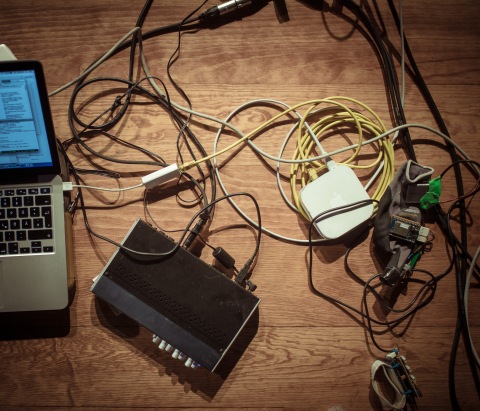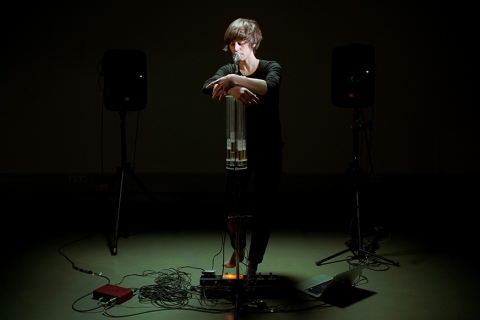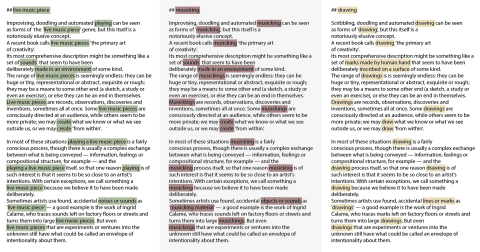2016, Till Bovermann
Instrument sets of the experimental musicians playing at the closing concert of the 3DMIN project (2016). Continue reading

2016, Till Bovermann
Instrument sets of the experimental musicians playing at the closing concert of the 3DMIN project (2016). Continue reading

2016, Alberto de Campo
The notion of MetaControl occurred to me while I was collaborating on the modality toolkit, a software library based on the idea of highly modal interfaces/instruments, i.e. setups where a small number of physical interfaces can access and control a variety of processes in a great variety of ways.
Continue reading

2016, Katharina Hauke
The evolution of voice started way before of the evolution of speech (which is quite a recent development in the process of evolution). Hence it allies us with our surroundings on a more basic, fundamental level. A connection through vibrations – via material that connects us (air, water, skin, to name a few) and that can be considered as you, as me, as not a part of either of us, as both of us, as a moving a margin…

Original (“drawing”) found on p. 17 of: Maclagan, D. (2013). Line Let Loose: Scribbling, Doodling and Automatic Drawing. Reaktion Books. Variations by Till Bovermann (2014). Continue reading

2015, Sarah-Indriyati Hardjowirogo
By the term instrumentality I refer to the potential property of things to be used as musical instruments or, more precisely, to their instrumental potential as such. While sharing the assumption that virtually anything –a shoe, a bottle, a pen– can become a musical instrument under certain conditions, I keep wondering what exactly these conditions are. Utilitarian approaches to this question, such as It’s a musical instrument if it is used as a musical instrument, are by no means trivial since they emphasize the importance of a purposeful use for the process that turns an arbitrary object into a commodity with a well-defined function. Still, I cannot help finding this kind of circular reasoning hardly satisfactory: What, then, does it mean to use something as a musical instrument? What are the actions and procedures associated with musical instruments? What kind of mental and physical knowledge do we have to access in order to recognise or use something as a musical instrument? How is this knowledge being shaped by cultural conventions and temporal conditions? And, finally, how has this complex structure of actions, knowledge and meaning changed over time? More broadly, what are the conditions that constitute a musical instrument as such?
Continue reading

2015, Victor Zappi, Andrew McPherson
Many digital musical instruments (DMIs) are created every year, but very few of them have a long life and a wide diffusion. Even within the relatively small DMI performer community, it is common to see a beautifully crafted design being put aside when a new technology is made available. By contrast, familiar acoustic and electric instruments have acquired their current identity through generations of design revisions and performance practice. Why is it so common that even the best DMIs disappear after a few performances, or at best, are used in the longer term by only a handful of musicians? Continue reading
2015, Ken Butler
Given the constant output of large variety of sonic devices from contemporary technology, an important distinction in characterizing a contemporary musical instrument, in my mind, is the clarification of the overlap and characteristics of an “instrument” for making music and a “controller” for making sounds. Continue reading

2014, Dafna Naphtali
As an electronic musician, I am largely occupied with capturing and manipulation of sound in real time — the sound of instruments being played by other musicians. I am also a vocalist, and often my instrument(s) are perceived as being “invisible”.
“Real-time live sound processing“, “audio machinations”, “{kaleid-o-phone}” – are all terms I’ve used to describe what I do, since I first started in the mid-90’s, dragging a Mac-plus computer and MIDI controllable effects units to clubs and venues, lots of equipment so that I could experiment, and find a way to play sound manipulations in a musically reactive way, especially in improvised contexts.
2014, Gina Emerson
The term ‘experimental’ appears frequently in new music discourse but is rarely clearly defined. Applied to the practice of designing contemporary musical instruments, experimentalism can be seen to manifest itself in two central ways:
Continue reading

You must be logged in to post a comment.